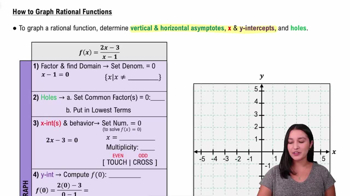Table of contents
- 0. Review of Algebra4h 16m
- 1. Equations & Inequalities3h 18m
- 2. Graphs of Equations43m
- 3. Functions2h 17m
- 4. Polynomial Functions1h 44m
- 5. Rational Functions1h 23m
- 6. Exponential & Logarithmic Functions2h 28m
- 7. Systems of Equations & Matrices4h 6m
- 8. Conic Sections2h 23m
- 9. Sequences, Series, & Induction1h 19m
- 10. Combinatorics & Probability1h 45m
0. Review of Algebra
Exponents
Problem 143
Textbook Question
Write each fraction as a decimal. For repeating decimals, write the answer by first using bar notation and then rounding to the nearest thousandth. 9/4
 Verified step by step guidance
Verified step by step guidance1
Convert the fraction \( \frac{9}{4} \) into a decimal by performing the division 9 divided by 4.
Determine if the decimal is terminating or repeating. Since 9 divided by 4 results in a terminating decimal, there is no repeating part.
Write the decimal result from the division.
Since the decimal is terminating, there is no need for bar notation.
Round the decimal to the nearest thousandth, if necessary.
Recommended similar problem, with video answer:
 Verified Solution
Verified SolutionThis video solution was recommended by our tutors as helpful for the problem above
Video duration:
1mPlay a video:
Was this helpful?
Key Concepts
Here are the essential concepts you must grasp in order to answer the question correctly.
Fractions and Decimals
Fractions represent a part of a whole and can be converted into decimals. The fraction 9/4 indicates that 9 is divided by 4, which results in a decimal value. Understanding how to perform this division is essential for converting fractions to decimals accurately.
Recommended video:
Guided course

Radical Expressions with Fractions
Repeating Decimals
Repeating decimals occur when a decimal representation of a fraction has a digit or group of digits that repeat indefinitely. For example, when converting certain fractions, such as 1/3, the result is 0.333..., which can be denoted using bar notation as 0.3̅. Recognizing and representing repeating decimals correctly is crucial for precise mathematical communication.
Recommended video:

How to Graph Rational Functions
Rounding Numbers
Rounding is the process of adjusting a number to a specified degree of accuracy, often to simplify calculations or results. When rounding to the nearest thousandth, one looks at the digit in the fourth decimal place to determine whether to round up or down. This concept is important for providing a concise and manageable representation of decimal values.
Recommended video:

The Number e

 7:39m
7:39mWatch next
Master Introduction to Exponent Rules with a bite sized video explanation from Patrick Ford
Start learningRelated Videos
Related Practice













